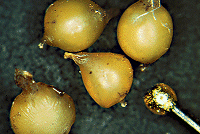
earthworms
Worms are a wonder of the soil. They eat mineral and organic matter which they grind up in their gut, producing their own weight in worm casts everyday which are highly fertile, containing nitrogen, phosphorous, potassium, magnesium and calcium. The casts are held together by gums and lime, and contains calcium that encourages bacteria that secrete vitamin B12, a natural chemical that has been shown to improve crop yield. Worms are excellent for general soil structure as they dig channels through the soil that encourages deep rooting, and increases soil aeration and drainage in the ground.
.
.
.
Should I encourage earthworms in lawns?
.
Do earthworms surface during heavy rain to avoid drowning?
.
How do earthworms reproduce young?
..
SPACE
SPACE
Casts are undigested worm waste and are made up from organic matter mixed with soil and cemented together with a "gum". The gum is produced by microscopic, very active bacteria, and mucus. Earthworms create smooth walls to their burrows using their waste and deposit "casts" on the surface.
SPACE
SPACE
Should I encourage earthworms in lawns?
The short answer is yes. Worm casts in lawns are an indication of a healthy soil, as the casts form clumps or granules that will help combat soil erosion. The tunnelling aerates the soil and aids water and nutrient infiltration to lower levels. Earthworms plough the soil and fertilise it at the same time. So the advantages of having a good earthworm population far outweigh the single disadvantage of casts on the surface of your lawn. These principals apply, not only to lawns, but to the rest of your garden as well.
SPACE
SPACE
Do earthworms surface during heavy rain to avoid drowning?
No. This is a major myth as earthworms surface as a response to high relative humidity after rain, which enables them to move around without dehydration and to find a mate. They can survive in water for a few weeks providing the oxygen content of the water is high enough to support them. Earthworms have no lungs, and take in oxygen directly through their skin either from the air or from water.
Earthworms are hermaphroditic which
means they have the organs of both sexes. The male
genopores are in the first twelve to fifteen segments
while the female genopores are nearer to the clitillum
(the "lump" in adult worms). They mate
juxtaposing opposite gonodal openings and sperm packets
(spermatophores) are exchanged. Some species are
parthenogenic, or may be able to self fertilize. The
production of young begins with the clitillum producing a
mucous sheath and nutrients. As the sheath slides forward
towards the front end it picks up eggs from the overies
and packets of sperm that had been deposited from another
worm during mating. The sheath slides over the worms head
and the ends are sealed to shape and form the cocoon.
Soon after being deposited in the soil they turn leathery
and amber in colour, and when the embryos have used up
all the nutrients they are ready to hatch out. The
gestation period varies from three weeks to five months
depending on species. Soil conditions have an infleunce
too, and hatching will be delayed if these are not right.
